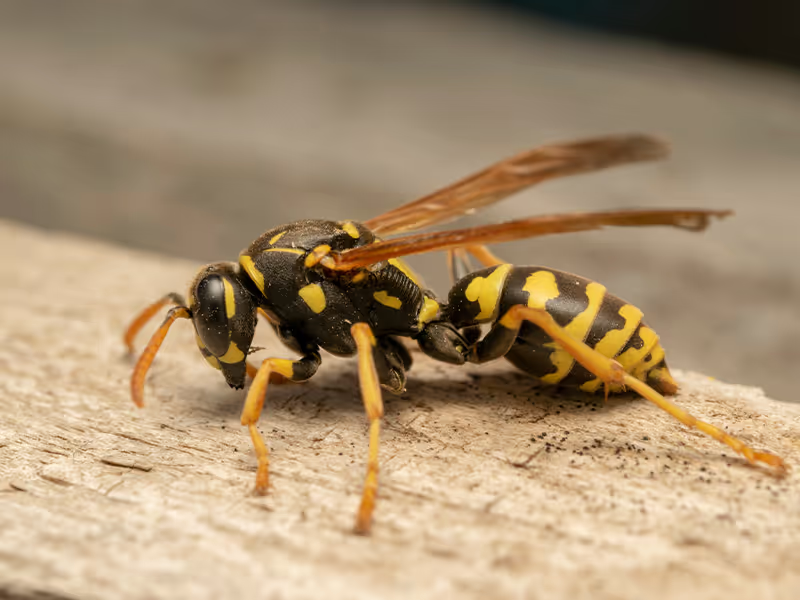Paper wasps are long and narrow with a noticeably pinched waist. They’re usually brown or black with yellow or reddish markings, and they grow to about ¾ to 1 inch in length. Their long legs dangle beneath them as they fly, which makes them easy to spot.
You might also notice their nests nearby. Paper wasp nests are gray, umbrella-shaped, and made from a papery material that resembles dried wood pulp. The open comb cells are visible from below.

Paper wasps are more slender and build open, above-ground nests. Yellow jackets are shorter, more compact, and often build enclosed nests underground or inside walls.
A paper wasp nest looks like an upside-down umbrella made from gray, papery material. It has open hexagonal cells where the wasps raise their young, and you can usually see these cells clearly from below. Unlike hornet or yellow jacket nests, which are enclosed, a paper wasp nest is exposed and not surrounded by a paper covering.
Most nests are about the size of a golf ball early in the season, but they can grow larger as more wasps join the colony. In San Diego, you’ll often find these nests attached to eaves, porch ceilings, patio furniture, or tree branches. They hang from a single stalk and are usually tucked into quiet, sheltered spots.
Paper wasps like to build nests in quiet, shaded areas that are protected from wind and rain. Common nesting spots include:
While paper wasps don’t reuse old nests, they may build new ones in the same area each year.
Adult paper wasps feed on nectar, plant juices, and other sugary liquids. You might see them visiting flowers or hovering around fruit trees in your yard. They’re also attracted to sweet drinks and food left out on patios or picnic tables.
While adults prefer sugary stuff, they hunt insects like caterpillars and flies to feed their larvae. They chew up the insects into a soft paste and deliver it back to the nest for their young.
Not usually. Paper wasps are considered less aggressive than yellow jackets, but they will sting if they feel their nest is threatened. If you accidentally get too close, they may defend their nest with a painful sting. People who are allergic to wasp stings should be especially cautious.
Paper wasp stings can be painful but are usually not dangerous for most people. The sting causes a sharp, burning pain followed by redness, swelling, and itching around the area. For someone without allergies, the discomfort usually goes away within a few hours to a couple of days.
However, stings can be dangerous for people who are allergic to wasp venom. In those cases, a sting can lead to a severe allergic reaction called anaphylaxis, which may include trouble breathing, swelling of the face or throat, dizziness, or a rapid heartbeat. If that happens, it’s a medical emergency and requires immediate attention.
Even without an allergy, getting stung multiple times—especially near the face or neck—can lead to more serious swelling or discomfort. That’s why it’s best to keep your distance from active nests and call a pest control professional if you find one near your home.
Paper wasps are looking for safe places to build nests and food sources. They’re drawn to:
Keeping these attractants in check can reduce the chances of a wasp problem.
If paper wasps are nesting too close to your home or areas where your family spends time, contact Harbor Pest Control for assistance. Our local pest control pros help San Diego residents resolve stinging insect issues using the proper equipment and safety gear. Let our team handle paper wasps so you don’t have to worry about being stung!
To help keep paper wasps away:
Removing nests early in the season, before they grow large, can also help. Just be sure they’re inactive before attempting removal or call a professional.





Helpful Tips & Info